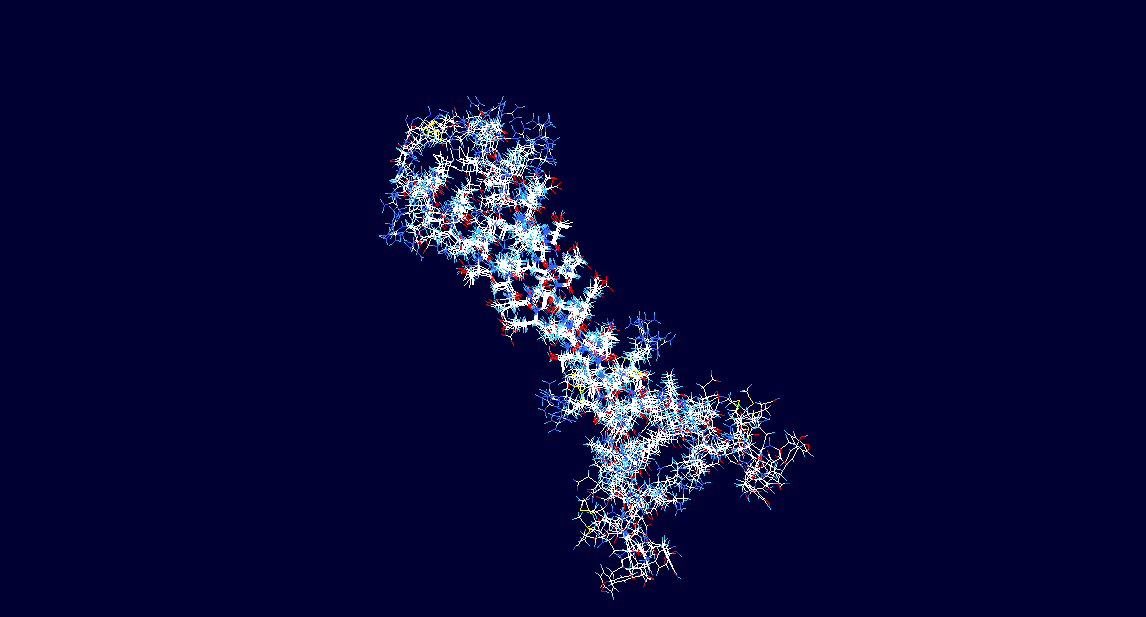C-JUN
From Proteopedia
| Line 5: | Line 5: | ||
= C-JUN = | = C-JUN = | ||
<applet load='1Z82' size='300' frame='true' align='right' caption='1JUN' /> | <applet load='1Z82' size='300' frame='true' align='right' caption='1JUN' /> | ||
| - | <ref name=”placeholder”> XXX </ref> | ||
| - | |||
| - | The C-Jun protein belongs the member of the basic region leucine zippere (bZIP) family of transcription factors. All these factors bind to DNA as either homo or heterodimers <ref name="ref1"> PMID:8662824 </ref>. This union of the two identical molecular units is mediated by each of their leucine zipper domains and subsequently a prerequisite to the binding of their related DNA enhancer elements <ref name="ref1"/>. This prerequisitie is needed as dimerization enables the alpha helical DNA binding domains to be inserted into adjacent grooves of the dyad symmetrical DNA recognition site. this therefore affects the activity of how these proteins are regulated by causing these protein to protein interactions between the leucine zipper domains in addition to the interactions between protein and DNA <ref name="ref1"/>. | ||
| + | [[Image:1JUN.png]] | ||
| + | The c-Jun protein is a member of transcription factors which consist of a basic region leucine zipper region <ref name="ref1"> PMID:8662824 </ref>. All these leucine zipper factors bind to DNA in one of two states: homo or heterodimers <ref name="ref1"/>.. In conjunction with the c-Fos protein these two proteins bind to specific regions of DNA strands. Together these two proteins form the c-fos/c-jun complex which help regulate cell growth and differentiation <ref name="ref1"/>. Regulation of the complex iteslf is done by interactions between the protein and DNA in addition to the protein-protein interactions between each of the leucine zipper domains <ref name="ref1"/>. | ||
| + | |||
== Introduction == | == Introduction == | ||
| + | |||
C-Jun binds to specific DNA sites either in the homodimer or deterodimer forms with the aid of C-Fos protein <ref name="ref1"/>. C-Jun is a transcriptional activator <ref name="ref1"/>. C-jun, with the aid of C-Fos represents a crucial union between normal and uncontrolled cell growth as their combined role in the transduction of afferent growth signals the response of specific genes <ref name="ref1"/>. | C-Jun binds to specific DNA sites either in the homodimer or deterodimer forms with the aid of C-Fos protein <ref name="ref1"/>. C-Jun is a transcriptional activator <ref name="ref1"/>. C-jun, with the aid of C-Fos represents a crucial union between normal and uncontrolled cell growth as their combined role in the transduction of afferent growth signals the response of specific genes <ref name="ref1"/>. | ||
| Line 22: | Line 23: | ||
== Protein Function == | == Protein Function == | ||
| - | [[Image:1JUN.png]] | ||
== OTHER == | == OTHER == | ||
Revision as of 03:09, 1 April 2010
Andrew Rebeyka
| Please do NOT make changes to this Sandbox until after April 23, 2010. Sandboxes 151-200 are reserved until then for use by the Chemistry 307 class at UNBC taught by Prof. Andrea Gorrell. |
|
 The c-Jun protein is a member of transcription factors which consist of a basic region leucine zipper region [1]. All these leucine zipper factors bind to DNA in one of two states: homo or heterodimers [1].. In conjunction with the c-Fos protein these two proteins bind to specific regions of DNA strands. Together these two proteins form the c-fos/c-jun complex which help regulate cell growth and differentiation [1]. Regulation of the complex iteslf is done by interactions between the protein and DNA in addition to the protein-protein interactions between each of the leucine zipper domains [1].
The c-Jun protein is a member of transcription factors which consist of a basic region leucine zipper region [1]. All these leucine zipper factors bind to DNA in one of two states: homo or heterodimers [1].. In conjunction with the c-Fos protein these two proteins bind to specific regions of DNA strands. Together these two proteins form the c-fos/c-jun complex which help regulate cell growth and differentiation [1]. Regulation of the complex iteslf is done by interactions between the protein and DNA in addition to the protein-protein interactions between each of the leucine zipper domains [1].
Introduction
C-Jun binds to specific DNA sites either in the homodimer or deterodimer forms with the aid of C-Fos protein [1]. C-Jun is a transcriptional activator [1]. C-jun, with the aid of C-Fos represents a crucial union between normal and uncontrolled cell growth as their combined role in the transduction of afferent growth signals the response of specific genes [1].
Structural Overview
This protein is a dimer that is completely symmetrical [2](a). It is comprised of coiled coil of two alpha helices [2]Proteopedia Page Contributors and Editors (what is this?)
Andrew Rebeyka, Michal Harel, Alexander Berchansky, David Canner, Andrea Gorrell
